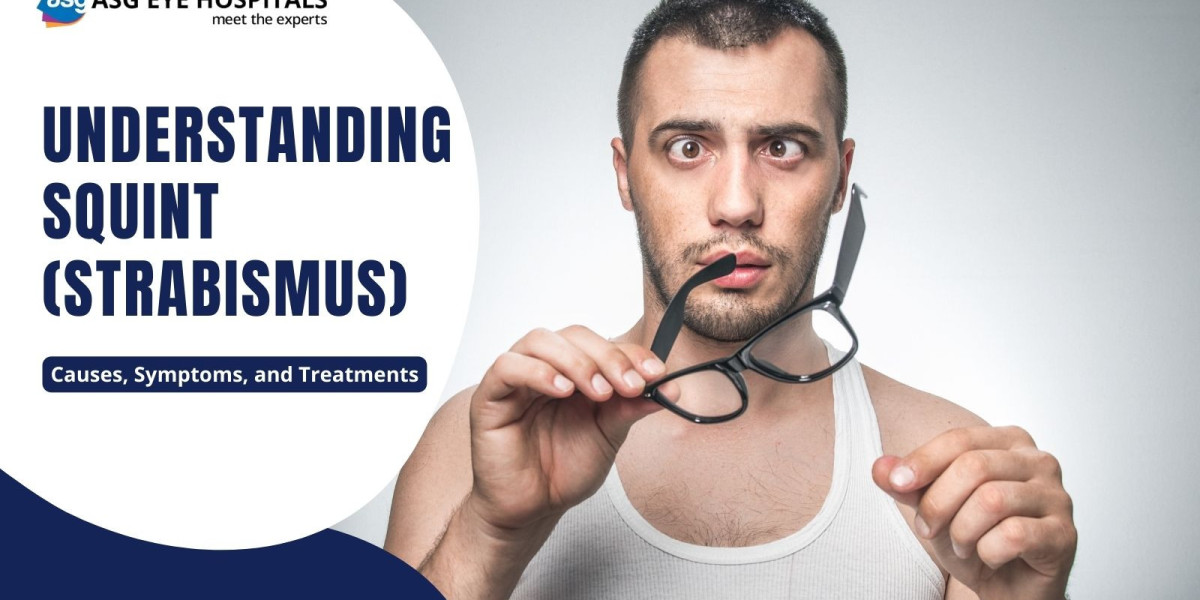A squint, medically known as strabismus, is a condition where the eyes are not properly aligned with each other. This misalignment can cause one eye to look straight ahead while the other turns inward, outward, upward, or downward. Squint is a common eye problem that affects both children and adults, and understanding its causes, symptoms, and available squint eye treatment options is crucial for those affected by this condition.
What Causes Squint?
Squint can occur due to various factors, and understanding these causes is essential for effective squint eye treatment. Some common causes include:
- Refractive Errors: Conditions like myopia, hyperopia, or astigmatism can lead to squint.
- Muscle Control Issues: Problems with the muscles that control eye movement can result in misalignment.
- Genetics: Some forms of squint can be hereditary.
- Neurological Problems: Certain neurological conditions can affect eye alignment.
- Trauma: Injuries to the eye or surrounding areas can cause squint.
- Childhood Illnesses: Some childhood diseases can lead to the development of squint.
Types of Squint
Understanding the different types of squint is crucial for determining the most appropriate squint eye treatment. The main types include:
- Esotropia: Inward turning of the ey
- Exotropia: Outward turning of the eye
- Hypertropia: Upward turning of the eye
- Hypotropia: Downward turning of the eye
Each type may require a different approach to treatment, highlighting the importance of accurate diagnosis.
Symptoms of Squint
Recognizing the symptoms of squint is the first step towards seeking appropriate squint eye treatment. Common symptoms include:
- Noticeable misalignment of the eyes
- Double vision
- Poor depth perception
- Eye strain or fatigue
- Frequent head tilting or turning
- Closing one eye in bright light
If you or your child experiences any of these symptoms, it's important to consult an eye care professional for a thorough examination.
Diagnosis of Squint
Proper diagnosis is crucial for effective squint eye treatment. An eye care professional will typically perform:
- Visual Acuity Tests: To check the sharpness of vision in each eye
- Refraction Assessment: To determine if there are any refractive errors
- Eye Movement Examination: To evaluate how well the eyes move and work together
- Comprehensive Eye Exam: To check the overall health of the eyes
In some cases, additional tests like CT scans or MRIs may be necessary to rule out other underlying conditions.
Squint Eye Treatment Options
The choice of squint eye treatment depends on various factors, including the type and severity of the squint, the patient's age, and overall health. Here are some common treatment options:
1. Corrective Lenses
For squints caused by refractive errors, prescription glasses or contact lenses can often help correct the misalignment. This non-invasive squint eye treatment is often the first line of approach, especially in children.
2. Vision Therapy
Vision therapy involves a series of eye exercises designed to improve eye coordination and alignment. This form of squint eye treatment can be particularly effective for certain types of squint, especially when combined with other treatments.
3. Patching
In cases where one eye is weaker than the other (a condition known as amblyopia), patching the stronger eye can encourage the weaker eye to work harder, potentially improving alignment.
4. Prism Lenses
Special prism lenses can be incorporated into glasses to help align images and reduce double vision, offering a non-surgical squint eye treatment option for some patients.
5. Botox Injections
In some cases, Botox injections into the eye muscles can help correct the misalignment. While not a permanent solution, this squint eye treatment can be effective for certain types of squint.
6. Surgery
For more severe cases or when other treatments haven't been successful, squint eye surgery may be recommended. This involves adjusting the muscles that control eye movement to improve alignment.
The Importance of Early Intervention
Early detection and treatment of squint are crucial, especially in children. If left untreated, squint can lead to:
- Permanent vision loss in the affected eye
- Poor depth perception
- Social and psychological challenges
Therefore, regular eye check-ups for children and prompt attention to any signs of misalignment are essential.
Living with Squint: Beyond Medical Treatment
While medical squint eye treatment is crucial, living with squint often involves more than just addressing the physical aspects of the condition. Here are some additional considerations:
Emotional and Social Support
Individuals with squint, especially children, may face social challenges or self-esteem issues. Providing emotional support and encouragement is an important part of the overall treatment process.
Adaptive Strategies
Developing strategies to cope with visual challenges, such as adjusting head position or using visual aids, can help individuals with squint navigate daily activities more comfortably.
Regular Follow-ups
Consistent follow-up appointments are crucial to monitor progress and adjust treatment plans as needed. This ongoing care is an integral part of successful squint eye treatment.
Preventive Measures and Eye Health
While not all cases of squint can be prevented, maintaining good eye health can help reduce the risk of developing certain types of squint. Some preventive measures include:
- Regular eye check-ups, especially for children
- Protecting eyes from injury
- Managing underlying health conditions that could affect eye health
- Maintaining a balanced diet rich in eye-healthy nutrients
Conclusion
Squint is a complex condition that can significantly impact an individual's vision and quality of life. However, with early detection and appropriate squint eye treatment, many cases can be successfully managed or corrected. Whether through non-invasive methods like corrective lenses and vision therapy, or more intensive interventions like surgery, there are numerous options available for those affected by squint.
If you suspect that you or a loved one may have a squint, don't hesitate to seek professional advice. Remember, early intervention is key to achieving the best possible outcomes. With the right care and support, individuals with squint can lead full, active lives with good vision and eye health.
By staying informed about the causes, symptoms, and treatment options for squint, you're taking an important step towards better eye health for yourself and your loved ones. Regular eye check-ups and prompt attention to any vision concerns are the best ways to ensure healthy eyes and clear vision for years to come.








